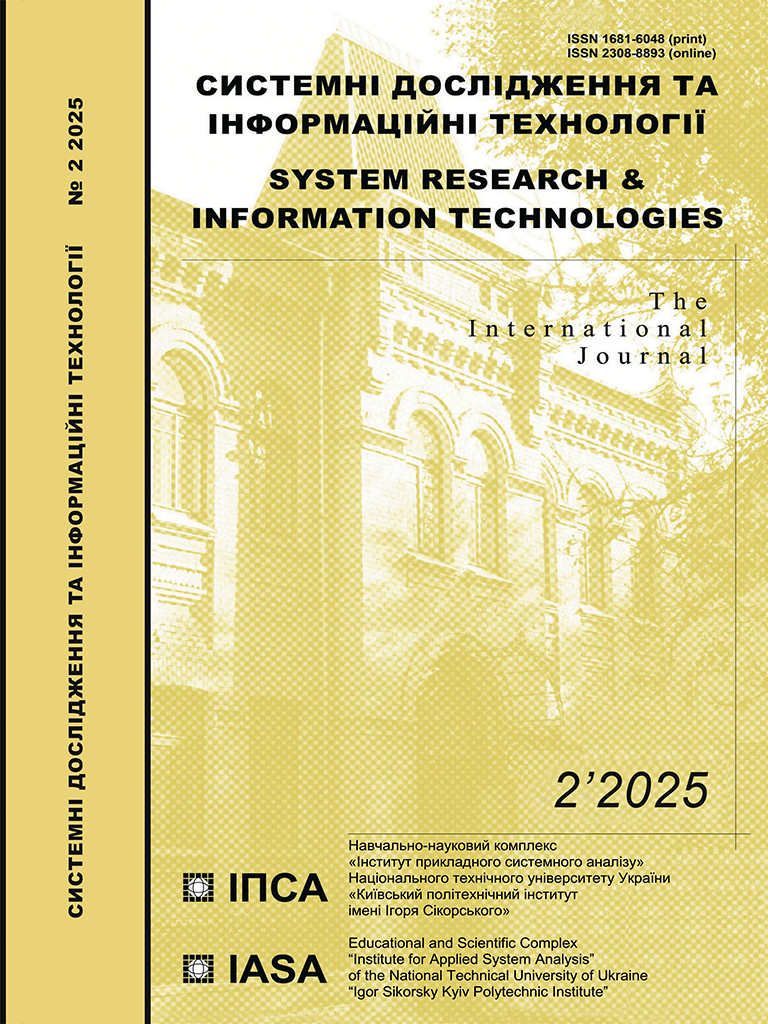From CAD and BIM to digital twins
DOI:
https://doi.org/10.20535/SRIT.2308-8893.2025.2.01Keywords:
mathematical modeling, digital modeling, CAD and BIM, Digital Twins (DT), Internet of Things (IoT), AI application in DTAbstract
A Digital Twin is a virtual model of a physical object or system that uses real-time data to simulate the behavior of its real counterpart. It can be a product, machine, building, or even an entire city. Digital modeling is a fundamental technology for creating Digital Twins, as it provides a methodology for representing physical objects in the virtual world. CAD (Computer-Aided Design) can be used to create the initial model of a Digital Twin. BIM (Building Information Modeling) is a specialized form of CAD that focuses on building projects incorporating more information than just geometry but also data on time, costs, operations, and maintenance. This paper examines how these technologies are increasingly integrated with each other, utilizing mathematical modeling that, through virtual computational experiments, provides an understanding of the complex functioning of objects and informed decision-making in various fields. The integration of Digital Twins and CAD is transforming the ways products are designed, modeled, and optimized in the industry. BIM models can serve as the basis for creating Digital Twins of buildings, which are then used to optimize energy consumption, maintenance, and repair. With the growth of the Internet of Things (IoT), Digital Twins are receiving more and more real data, making them even more accurate and useful for forecasting and optimization. The use of artificial intelligence to analyze data collected by digital twins allows predicting breakdowns, optimizing processes, and even automating the control of systems.
References
A. Petrenko, “Optimal Engineering Design Based on Service-Oriented Computing (SOC). Chapter 7,” Book “Research Highlights in Science and Technology,” Vol. 4. UK: B P International publishes, 17 June 2023, pp. 97–106. doi: https://doi.org/10.9734/bpi/rhst/v4/10278F
A. Petrenko, V. Ladogubetz, V. Chkavov, J. Pudlowski, ALLTED: a Computer-Aided Engineering System for Electronic Circuit Design. Melbourne, UICEE, 1997, 206 p. Available: https://unesdoc.unesco.org/ark:/48223/pf0000156798
CAD and BIM: Bridging the Gap Between Digital and Physical Construction - Current Trends and Insights. Available: https://www.linkedin.com/pulse/cad-bim-bridging-gap-between-digital/
BIM vs CAD: Exploring the key differences. Available: https://www.bimcollab.com/en/resources/blog/bim-vs-cad-comparison/
Liu Zihe, “Comparison and analysis of advantages and disadvantages between BIM and CAD in civil drafting software,” Applied and Computational Engineering, 62(1), pp. 192–197, May 2024. doi: 10.54254/2755-2721/62/20240426.
Scan to BIM: Reality capture meets actionable data models. Available: https://www.autodesk.com/industry/land-development/scan-to-bim
N.D. Pankratova, K.D. Grishyn, V.E. Barilko, “Digital Twins: stages of concept development, areas of use, prospects,” System Research and Information Technologies, no. 2, pp.7–21, 2023. doi: https://doi.org/10.20535/SRIT.2308-8893.2023.2.01
F. Tao, H. Zhang, A. Liu, A.Y.C. Nee, “Digital Twin in Industry: State-of-the-Art,” in IEEE Transactions on Industrial Informatics, vol. 15, no. 4, pp. 2405–2415, April 2019. doi: 10.1109/TII.2018.2873186.
Digital Twin Technology & CAD, February 2, 2025, Computer-Aided Engineering. Available: https://cadifystudio.com/digital-twin-technology-and-cad-its-benefits-and-applications/
Angira Sharma, Edward Elson Kosasih, Jie Zhang, Alexandra Melike Brintrup, “Digital Twins: State of the art theory and practice, challenges, and open research questions,” Journal of Industrial Information Integration, 30(1), 100383, August 2022. doi: 10.1016/j.jii.2022.100383.
L. Wright, S. Davidson, “How to tell the difference between a model and a Digital Twin,” Adv. Model. and Simul. in Eng. Sci., 7, 13 (2020). doi: https://doi.org/10.1186/s40323-020-00147-4
Nataliya Pankratova, Igor Golinko, “Electric heater mathematical model for cyber-physical systems,” System Research and Information Technologies, no. 2, pp. 7–17, 2021. doi: 10.20535/SRIT.2308-8893.2021.2.01.
Nataliya Pankratova, Igor Golinko, “Development of Digital Twins to Support the Functioning of Cyber-physical Systems,” Computer Science Journal of Moldova, vol. 31, no. 3(93), pp. 299–320, 2023. doi: https://doi.org/10.56415/csjm.v31.15
Tim Kreuzer, Panagiotis Papapetrou, Jelena Zdravkovic, “Artificial intelligence in Digital Twins—A systematic literature review,” Data & Knowledge Engineering, vol. 151, May 2024. doi: https://doi.org/10.1016/j.datak.2024.102304

